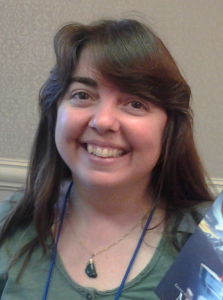A guest post by Emily Godhand.
When it comes to actually reacting to the threat, there are many factors that determine if the character will Fight, Flee, Freeze, or Fawn. In his book “Violence: A Writer’s Guide”, Rory A. Miller talks about how violence is, at its simplest, a tool. He discusses how our psychosocial conditioning can heavily influence how we wield and react to violence. Essentially, we use what has worked in the past.
It’s in our nature to find a way to adapt to situations. So a character who was discouraged from solving confrontations physically might find another way to ‘fight’. Therefore fighting need not be entirely explained as a “physical confrontation” within this context.
‘Fight’ can be explained as a show of resistance:
*Physical attack/counter-attack
*Defense (block, redirect, dodge)
*Passive-Aggressive actions or words (“Whatever, do what you want.”)
*Verbal confrontation
*Willfully refusing to fight (”Turn the other cheek” )
Imagine these responses as a spectrum of difficulty; If a character has been allowed to get away with physical violence, or been encouraged to use it, they are more likely engage with violence than someone who has been conditioned to “find another way”.
…hitting people is a hard mental barrier to overcome.
Flight is avoidance of the stressor:
So if fighting is ruled out either by reason or socialization, it makes sense then that your character would want to find a way out. This could be through physically escaping or some attempt to gracefully back out of the situation without tripping over their proverbial train.
There may be situations in which your character can’t reasonably escape, such as in a child in a classroom (he can’t leave school without repercussions), a worker at the job site (they need the money), or fleeing results in negative repercussions (such as in learned helplessness).
If the body is unable to flee, the mind still may. Your character may start to disassociate from the situation, fantasize, or even turn to chemical means of escape.
Freeze is the body shutting down:
And if fighting and fleeing are both ruled out either by reason, socialization, or fear, the body may freeze. In this way, the mind may be perfectly willing to engage or flee if it’s not choked with fear, but the body itself may betray your character and refuse to move. The mind may even disassociate to spare itself from an expected horror. This “playing possum” or “deer in headlights” response is a legitimate survival tactic. Motion may draw a predator’s attention whereas stillness may go unnoticed. Our society expects some sort of active response to a threat, so people who react with ‘freeze’ aren’t likely to see it as a way they survived. Instead they may feel a sense of failure and shame.
Fawn is mitigating the situation:
So if you can’t beat ‘em, and you can’t flee’em, what can you do? You’re left with “Join’em”.
This can also be called “Tend and Befriend” but scientists have an affinity for alliteration and rhyme. This more often seen in women due to socialization within our society. However it is not inherent. Any character may find merit in feigning surrender and working for/with the threat. Other ways this may present are seeking out the social group for protective safety, focusing on tending offspring, or diffusing the situation through diplomacy.
The degree and rate to which adrenaline is released differs by psychosocial history.
Multiple influences, as addressed in the first part, factor into the degree to which we perceive something to be a threat. The more something is perceived as a threat, the stronger the adrenaline reaction tends to be. But the rate at which that adrenaline is released and processed can differ from person to person.
An anticipated threat allows for the adrenaline to “trickle out”. If the character has been trained they can use that to prepare themselves. And if they can’t, the fear can build upon itself until they are overwhelmed. If your character is overwhelmed by uncontrolled adrenaline they are more likely to freeze if they don’t have the muscle memory from training to immediately take control.
By its very nature, an ambush catches the victim without the benefits of an adrenaline rush. Without adrenaline, people are more likely to freeze.
Managing adrenaline comes from training in the environment
Characters who have any degree of training over regulating their emotions, stress, and the social rules of engagement, from school-yard play fights to trained martial operatives, are going to have an advantage over characters who haven’t had any such training.
Sometimes that training isn’t enough. In order to be effective, training needs to be continuous and as close to real world conditions as possible.
An eight-hour “self-defense” isn’t likely to develop muscle memory. A martial arts class may only teach competition fighting, with staged and willful engagement may not prepare your character for the ambush of a street fight. Police officers practice shooting at the range, allowing them relative quiet to focus on perfecting their stance and breathing. However gunfights won’t happen in well-lit rooms while wearing appropriate ear protection. While good for the basics, range work doesn’t simulate the circumstances under which an officer is likely to draw his weapon.
Adrenaline is meant to keep someone alive, but even with the best of training under the best of comparable conditions, it can still work against your character.
Dilated pupils: Good to take in more information about your environment…or give you tunnel vision. Which means you may miss your opponent’s buddies coming in from the side. This can also skew your depth perception where your enemy, 20 feet off, sudden appears right in front of you.
Selective hearing: Also known as ‘auditory exclusion’, it is much like ‘tunnel vision for your ears’; you may not hear your comrades call out to take cover from the incoming grenade.
Increased muscle tone: For increased strength and speed. Side effect? Shaking. Trembling. Lack of fine motor control. The classic movie gesture of showing a man light a cigarette was to bring attention to this hands and how much they moved as an indication of how calm he was.
Increased strength: The reason we only get the levels of strength we do in stressful situations is it has become ‘Life or Death’, and life with torn muscles from overexertion is preferable to death.
Are the risks worth the engagement?
Engaging in conflict is not a decision you can take back, you can only mitigate the repercussions. You accept the risks and sign that contract with your life.
Potential Risks:
Physical harm, of any degree. What amount of harm are they willing to accept?
Social harm, of any degree. Will the crowd turn on you? Will you lose face?
Further escalation of violence. Will it make things worse?
Risk to others. Will I put others in danger?
Ego. Will I be able to live through and with the decision I make?
So all of you writing cops, soldiers, bad-asses, urban fantasy heroines, dystopian rebels, operators, and bildungsroman coming of age beating-up-your-bully stories, keep this in mind:
Committing violence is usually hard, even for the best of us.
About Emily Godhand:  Emily Godhand is a cross-genre author who lives in a book fort in Denver, CO, with nine rats who revere her as their Queen.As former psychiatric technician, she draws her inspirations from her work and the constant nightmares she’s had for 13 years. As such, her works tend to focus on an exploration of trauma, immortality, and human consciousness. Read her latest work on Wattpad, where she is an Ambassador.
Emily Godhand is a cross-genre author who lives in a book fort in Denver, CO, with nine rats who revere her as their Queen.As former psychiatric technician, she draws her inspirations from her work and the constant nightmares she’s had for 13 years. As such, her works tend to focus on an exploration of trauma, immortality, and human consciousness. Read her latest work on Wattpad, where she is an Ambassador.


